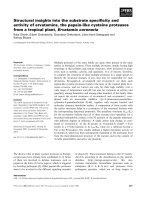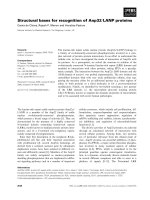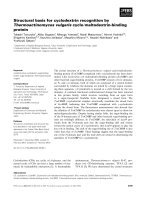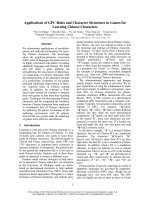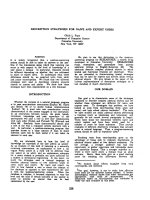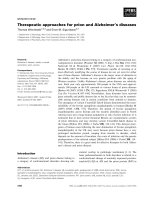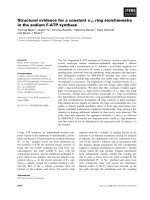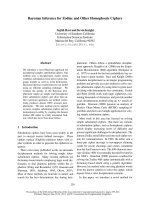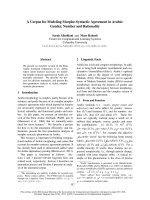Báo cáo khoa học: Structural origins for selectivity and specificity in an engineered bacterial repressor–inducer pair pdf
Bạn đang xem bản rút gọn của tài liệu. Xem và tải ngay bản đầy đủ của tài liệu tại đây (567 KB, 12 trang )
Structural origins for selectivity and specificity in an
engineered bacterial repressor–inducer pair
Michael A. Klieber
1
, Oliver Scholz
2,
*, Susanne Lochner
3
, Peter Gmeiner
3
, Wolfgang Hillen
2
and Yves A. Muller
1
1 Lehrstuhl fu
¨
r Biotechnik, Department of Biology, Friedrich-Alexander University, Erlangen-Nuremberg, Germany
2 Lehrstuhl fu
¨
r Mikrobiologie, Department of Biology, Friedrich-Alexander University, Erlangen-Nuremberg, Germany
3 Lehrstuhl fu
¨
r Pharmazeutische Chemie, Department of Chemistry and Pharmacy, Friedrich-Alexander University, Erlangen-Nuremberg,
Germany
Introduction
The bacterial repression system consisting of the effec-
tor molecule tetracycline, the tetracycline-inducible
repressor protein tetracycline repressor (TetR) and the
tet operator (tetO) has proven itself to comprise a
valuable tool for studying gene expression not only in
prokaryotes, but also in eukaryotes [1–3]. The repres-
sor protein TetR, and first and foremost its ability to
adopt different conformational states upon effector
Keywords
altered inducer selectivity; altered inducer
specificity; bacterial transcription regulation;
crystal structures; tetracycline repressor
Correspondence
Y. A. Muller, Lehrstuhl fu
¨
r Biotechnik,
Department of Biology, Friedrich-Alexander
University Erlangen-Nuremberg, Im IZMP,
Henkestrasse 91, D-91052 Erlangen,
Germany
Fax: +49 0 9131 8523080
Tel: +49 0 9131 8523081
E-mail:
*Present address
Department of Biochemistry, University of
Zurich, Switzerland
Database
Structural data are available from the Protein
Data Bank under the accession numbers
3FK6 for TetR(K
64
L
135
I
138
) alone and 3FK7
for the 4-ddma-atc complex
(Received 10 March 2009, revised 9 July
2009, accepted 31 July 2009)
doi:10.1111/j.1742-4658.2009.07254.x
The bacterial tetracycline transcription regulation system mediated by the
tetracycline repressor (TetR) is widely used to study gene expression in
prokaryotes and eukaryotes. To study multiple genes in parallel, a triple
mutant TetR(K
64
L
135
I
138
) has been engineered that is selectively induced
by the synthetic tetracycline derivative 4-de-dimethylamino-anhydrotetracy-
cline (4-ddma-atc) and no longer by tetracycline, the inducer of wild-type
TetR. In the present study, we report the crystal structure of
TetR(K
64
L
135
I
138
) in the absence and in complex with 4-ddma-atc at reso-
lutions of 2.1 A
˚
. Analysis of the structures in light of the available binding
data and previously reported TetR complexes allows for a dissection of the
origins of selectivity and specificity. In all crystal structures solved to date,
the ligand-binding position, as well as the positioning of the residues lining
the binding site, is extremely well conserved, irrespective of the chemical
nature of the ligand. Selective recognition of 4-ddma-atc is achieved
through fine-tuned hydrogen-bonding constraints introduced by the
His64 fi Lys substitution, as well as a combination of hydrophobic effect
and the removal of unfavorable electrostatic interactions through the intro-
duction of Leu135 and Ile138.
Abbreviations
atc, anhydrotetracycline; 4-ddma-atc, 4-de-dimethylamino-anhydrotetracycline; dox, 6-deoxy-5-hydoxy-tetracycline; PDB, Protein Data Bank;
tc, tetracycline; tetO, tet operator; TetR, tetracycline repressor; TetR(K
64
L
135
I
138
), TetR-BD triple mutant H64K, S135L and S138I.
5610 FEBS Journal 276 (2009) 5610–5621 ª 2009 The Authors Journal compilation ª 2009 FEBS
binding, plays a key role in this system. In the absence
of tetracycline, TetR binds with high affinity to the tet
operator tetO and thereby blocks the transcription of
any downstream genes. Upon binding of the inducer
tetracycline, the repressor TetR switches conformations
and dissociates from the operator DNA. As a result of
numerous functional and structural studies, the atomic
mechanism that underlies the functional switch in
TetR is now understood in significant detail [4–7].
To be able to control the expression of several genes
in parallel, TetR mutants have been isolated in elabo-
rate screens that respond to novel synthetic tetracycline
analogs [8,9]. One of these variants is the TetR triple
mutant TetR(K
64
L
135
I
138
) in which residues His64,
Ser135 and Ser138 of TetR have been replaced by Lys,
Leu and Ile, respectively [9]. This mutant is selectively
induced by the synthetic inducer 4-de-dimethylamino-
anhydrotetracycline (4-ddma-atc) and slightly by atc,
but no longer by tetracycline. To better understand the
switch in selectivity and the acquired novel specificity
of TetR(K
64
L
135
I
138
) for 4-ddma-atc, we solved the
crystal structure of TetR(K
64
L
135
I
138
) in the presence
and absence of 4-ddma-atc at resolutions of 2.06 and
2.1 A
˚
, respectively. We show that the effects of the
three mutations on ligand binding can be generally
thermodynamically dissected into individual contribu-
tions and that they originate from a favorable inter-
play of different physico-chemical properties, such as
solvation effects, constrained hydrogen-bonding geom-
etries and electrostatic discrimination.
Results
Comparison of the 4-ddma-atc-bound and free
overall TetR(K
64
L
135
I
138
) structure
As for all TetRs, TetR(K
64
L
135
I
138
) forms a dimer
and, with respect to the monomer architecture, each
chain contains an N-terminal DNA-binding domain
(residues 1–48) and a C-terminal effector-binding
domain (residues 49–205) [10] (Fig. 1A). The latter
also comprises the dimer interface. The two effector-
binding sites present in the dimer are identical and,
because the binding sites are located within the protein
interface, each binding site is lined by residues from
both monomers.
The overall structures of ligand-free TetR(K
64
L
135
I
138
) and of TetR(K
64
L
135
I
138
) in complex with
4-ddma-atc are very similar (for the chemical structure
of 4-ddma-atc and related TetR ligands, see Fig. 2).
The two crystals that have been used for structure
determination are highly isomorphous and only small
deviations occur in the cell axes (Table 1). They each
contain a complete dimer in the asymmetric unit.
Almost no differences exist between the monomers in
each crystal and the monomers ⁄ dimers between crys-
tals. The main chain atoms of the two monomers in
each crystal can be superimposed with rmsd of 0.92
and 1.34 A
˚
for the 4-ddma-atc-bound and effector-free
TetR(K
64
L
135
I
138
) structures, respectively. When direc-
tly comparing the structure of 4-ddma-atc-bound TetR
(K
64
L
135
I
138
) with that of effector-free TetR(K
64
L
135
I
138
), it is obvious that ligand binding does not induce
any considerable changes in the tertiary structures. The
four possible pairwise cross-superpositions between
crystals yield an rmsd in the range 0.52–1.23 A
˚
for a
total of 770 common main chain atoms. This shows
that the differences between the ligand-bound and
ligand-free structures are not larger than the differ-
ences observed between the two monomers present in
each crystal. To some extent, this is not too surprising
because the crystal with 4-ddma-atc bound was
obtained by soaking a ligand-free crystal with the
ligand. However, when considering the molecular
mechanism by which TetR exerts its function, then the
structural similarity might be considered unexpected.
A central function of TetR is its ability to adopt
different conformations. According to the conforma-
tional switch model, TetR exists in two conforma-
tions. In the ligand-free structure, the DNA-binding
heads are oriented such that TetR can readily bind
to the operator DNA, whereas, in effector-bound
TetR, the separation of the DNA-binding domain is
changed, such that TetR can no longer recognize the
tetO DNA sequence (Fig. 1A) [4]. However, as noted
above, the domain orientations in the 4-ddma-atc-
bound TetR(K
64
L
135
I
138
) and the ligand-free TetR
(K
64
L
135
I
138
) structure are very similar and resemble
that of induced TetR more closely than that of indu-
cer-free TetR (data not shown). Moreover, the main
chain of loop segment 100–105 that switches con-
formations upon effector binding is in an identical
conformation in both structures and resembles that
observed for induced TetR (Fig. 1C). In this confor-
mation, segment 100–105 moves towards the ligand
and thereby enables residues from the segment to
participate in ligand binding.
The observation that effector-free TetR(K
64
L
135
I
138
)
adopts an induced-like conformation must appear
unexpected. However, it can easily be rationalized if
alternative models are considered (e.g. the population
shift model) as explanations for the allosteric behavior
of TetR [11,12]. According to this model, effector-free
and DNA-free TetR is able to adopt a variety of
divers and freely inter-converting conformations.
Among these, there are also conformations that can
M. A. Klieber et al. Structure of an engineered TetR-inducer pair
FEBS Journal 276 (2009) 5610–5621 ª 2009 The Authors Journal compilation ª 2009 FEBS 5611
readily interact with DNA or that resemble the effec-
tor-bound conformation as, for example, observed in
the present study in the case of the crystal structure of
the effector-free TetR(K
64
L
135
I
138
). In this model,
induction can be explained by a shift of the population
towards a single DNA-binding incompetent conforma-
tion. Indications that such a population shift model
might apply to TetR have recently started to emerge
[13,14].
The effector-binding site of TetR(K
64
L
135
I
138
)in
the presence and absence of 4-ddma-atc
Particularly interesting with respect to the observed
specificity and selectivity of TetR(K
64
L
135
I
138
) for
4-ddma-atc are the interactions between the ligand
and the protein in the effector-binding site (Figs 1B
and 2A). Of the two binding sites that can be observed
independently in the 4-ddma-atc-complex structure,
A
C
B
Fig. 1. Crystal structure of TetR(K
64
L
135
I
138
) in complex with 4-ddma-atc. (A) Ca-representation of the TetR(K
64
L
135
I
138
) dimer (shown in dif-
ferent shades of magenta) in complex with 4-ddma-atc (shown in yellow) superimposed on wild-type TetR in complex with DNA (in black,
PDB entry: 1QPI) [6]. According to the generally agreed induction mechanism, effector binding to TetR induces a conformational change in
TetR, which alters the orientation and separation of the DNA-binding domains (indicated by two-headed arrows), so that TetR no longer
binds to the operator DNA. (B) Schematic representation of the interactions between 4-ddma-atc and TetR(K
64
L
135
I
138
). (C) Stereo represen-
tation of the structure of TetR(K
64
L
135
I
138
) in complex with 4-ddma-atc (shown in magenta and yellow) superimposed onto the effector-free
TetR(K
64
L
135
I
138
) structure (shown in grey). Of the two binding sites present in the crystal structure, binding site I (Table 2) is shown. The
binding sites are highly similar in the presence and absence of 4-ddma-atc. The loop segment 100–105 that switches conformations in other
ligand-free and ligand-bound TetR structures is only slightly displaced in ligand-free TetR(K
64
L
135
I
138
) compared to the ligand-bound TetR
structure.
Structure of an engineered TetR-inducer pair M. A. Klieber et al.
5612 FEBS Journal 276 (2009) 5610–5621 ª 2009 The Authors Journal compilation ª 2009 FEBS
both binding sites show the density for the ligand in
the initial difference-fourier electron density maps,
albeit to a different extent. The ligand is well defined
in binding site I, but only poor density has been
observed for the ligand in binding site II. To account
for this observation, the occupancy of the ligand in
binding site II was estimated at 50% and that in bind-
ing site I at 100%. When using these values during the
refinement, the temperature factors of the ligands
refine to values similar to those of the surrounding res-
idues, hinting that the estimated occupancies correctly
reflect those in the crystal. Inspection of the crystal
packing yields a plausible explanation for the differ-
ences in occupancies. In the crystal, the accessibility to
site II is impaired by the packing of neighboring mole-
cules, whereas site I appears to be readily accessible
through the solvent channels in the crystal.
When superimposing the two ligand-binding sites on
the basis of the coordinates of 93 residues surrounding
the ligands, it is obvious that the ligand is slightly
shifted in site II (Table 2). This shift is not only appar-
ent with respect to 4-ddma-atc bound to site I, but
also compared to various other ligand-TetR complexes
(Table 2). The two 4-ddma-atc molecules differ by an
rmsd of approximately 1 A
˚
, whereas the deviations
between 4-ddma-atc bound to site I and tetracycline
and 6-deoxy-5-hydoxy-tetracycline (dox) bound to
TetR [15,16], as well as atc bound to revTetR [14], are
in the range 0.4–0.5 A
˚
when considering 27 common
ligand atoms. We suspect that the positional shift of
the ligand in site II is related to the 50% occupancy.
The concomitant occurrence of ligand and water mole-
cules (also refined at 50% occupancy) at almost identi-
cal positions might lead to increased coordinate errors
during the refinement of the atomic positions and
hence a less accurate ligand positioning in site II.
Accordingly, the description of the binding of the
ligand in the present study is restricted to 4-ddma-atc
binding to site I in TetR(K
64
L
135
I
138
).
4-ddma-atc binding leads to only minor rearrange-
ments in the TetR(K
64
L
135
I
138
)-binding site (Fig. 1C).
Among the most notable changes are a slight shift of the
entire loop segment 100–105 in the direction of the
ligand, the presence of two alternative side chain confor-
mations for Asn82 in the 4-ddma-atc-bound structure
versus a single conformation in ligand-free
TetR(K
64
L
135
I
138
) and, finally, the occurrence of a
slightly different rotamer for Ile138 (i.e. different posi-
tioning of atom Cd) in the ligand-free and ligand-bound
structure. Overall, when considering both the main
chain fold and the conformations of the side chains, the
structures of ligand-free TetR(K
64
L
135
I
138
) and 4-ddma-
atc-bound TetR(K
64
L
135
I
138
) are very similar. This simi-
larity also extends to a number of water molecules that
occupy identical positions in the two structures.
Specific interactions between 4-ddma-atc and
TetR(K
64
L
135
I
138
)
TetR(K
64
L
135
I
138
) binds 4-ddma-atc via a number of
specific interactions (Fig. 3A). One of the most notable
ones involves Lys64. Atom Nf of Lys64 interacts with
two oxygen atoms of 4-ddma-atc, namely of the amide
group attached to atom C2 and the OH group
A
B
C
D
Fig. 2. Chemical structures of (A) 4-ddma-atc, (B) atc, (C) tetracy-
cline (tc) and (D) dox.
M. A. Klieber et al. Structure of an engineered TetR-inducer pair
FEBS Journal 276 (2009) 5610–5621 ª 2009 The Authors Journal compilation ª 2009 FEBS 5613
attached to atom C3 of 4-ddma-atc. Furthermore,
atom Lys64-Nf is located in hydrogen-bonding dis-
tance to the amide group of Asn82 and the main chain
carbonyl oxygen atom of Tyr66. It is not possible to
predict the strength of the interaction between Lys64
and 4-ddma-atc based on structural data only. For
Table 1. Data collection and refinement statistics.
Triple mutant
TetR(K
64
L
135
I
138
)
Triple mutant
TetR(K
64
L
135
I
138
) in complex
with 4-ddma-atc
Data collection statistics
Space group C2 C2
Unit cell parameters
a, b, c (A
˚
) 126.35, 58.06, 62.62 130.22, 59.38, 63.78
b (°) 96.58 97.85
Molecules per asymmetric unit 2 2
Resolution range (A
˚
)
a
15–2.1 (2.25–2.1) 20–2.06 (2.19–2.06)
Unique reflections 24749 29597
Redundancy 3.3 3.7
Completeness (%) 93.3 (95.9) 98.6 (91.8)
R
merge
(%) 6.4 (37.1) 6.0 (39.8)
Wilson B-factor (A
˚
2
) 15.1 26.5
Refinement statistics
Number of protein atoms, solvent
molecules and ligand atoms
3095, 116, 0 3180, 225, 58
R
work
(%) 21.6 20.3
R
free
(%) 26.2 26.1
rmsd bond lengths (A
˚
) 0.005 0.011
rmsd bond angles (°) 1.069 1.175
rmsd B-factors bonded atoms: main chain,
side chains (A
˚
2
)
1.51, 2.27 1.24, 2.13
Percentage of residues in most favored regions,
additional allowed, generously allowed and
disallowed regions of the Ramachandran plot
b
95.1, 4.9, 0.0, 0.0 95.5, 4.2, 0.3, 0.0
Average B-factor (A
˚
2
) 43.26 36.79
a
Values in parentheses refer to the highest resolution shell.
b
According to PROCHECK [27].
Table 2. Superposition of the ligand-binding sites and ligand positions in selected TetR complexes.
No ligand
TetR
(K
64
L
135
I
138
)I
a
No ligand
TetR
(K
64
L
135
I
138
)II
4-ddma-atc
TetR
(K
64
L
135
I
138
)I
a
4-ddma-atc
TetR
(K
64
L
135
I
138
)II
atc revTetR
(PDB code:
2VKV)
tc TetR(D)
(PDB code:
2VKE)
dox TetR(D)
(PDB code:
2O7O)
No ligand
TetR(K
64
L
135
I
138
)I
– 0.905, 1.396
b
0.532, 0.843 0.830, 1.360 0.854, 1.386 0.851, 1.385 0.870, 1.356
No ligand
TetR(K
64
L
135
I
138
)II
– – 0.788, 1.237 0.430, 0.771 0.631 1.168 0.576, 1.170 0.603, 1.102
4-ddma-atc
TetR(K
64
L
135
I
138
)I
– – – 0.633, 1.128 0.656, 1.155 0.615, 1.054 0.632, 1.047
4-ddma-atc
TetR(K
64
L
135
I
138
)II
– – 1.048
c
– 0.489, 1.062 0.432, 1.065 0.415, 0.999
Atc revTetR – – 0.431 0.896 – 0.413, 0.983 0.437, 0.918
tc TetR(BD) – – 0.456 1.024 0.270 – 0.216, 0.732
Dox TetR(BD) – – 0.523 0.878 0.259 0.265 –
a
Because the crystals contain two molecules in the asymmetric unit, two separate binding sites (I and II) are present in each of the two
TetR(K
64
L
135
I
138
) crystal structures.
b
Above the diagonal the rmsd (A
˚
) between structures of a selection of 93 residues surrounding the
ligand-binding site is reported (first number, rmsd obtained upon superposition of all main chain atoms of the selection; second number,
superposition of all atoms).
c
Below the diagonal: rmsd (A
˚
) calculated between the ligands (27 common ligand atoms) in the different com-
plexes after optimal superposition of the structures based on the main chain atoms of 93 residues surrounding the binding site.
Structure of an engineered TetR-inducer pair M. A. Klieber et al.
5614 FEBS Journal 276 (2009) 5610–5621 ª 2009 The Authors Journal compilation ª 2009 FEBS
example, the structure does not allow a distinction of
whether the side chain of Lys64 is protonated or not.
Uncertainties also arise with respect to the correct
orientation of the amide group attached to atom C2 of
4-ddma-atc, as well as the amide group of amino acid
Asn82, because the amide oxygen and nitrogen atoms
are indistinguishable at the resolutions of the solved
crystal structures. Because atom Nf of Lys64 can only
participate in three hydrogen bonds, it should be noted
that, of the four potential hydrogen bond acceptors ⁄
donors, atom O from the amide group of 4-ddma-atc
is the furthest apart (3.1 A
˚
versus 2.5–2.8 A
˚
for the
other hydrogen bond acceptors ⁄ donors). However, all
four potential hydrogen bond partners are geometri-
cally quite favorably placed. In all four cases, almost
ideal linear hydrogen bond geometries can be antici-
pated because the angle formed between atoms
Lys64-Ce, Lys64-Nf and the potential acceptor ⁄ donor
atoms are in the range 108–120°, in line with the
tetrahedral positioning of the hydrogen atoms attached
to Lys64-Nf.
TetR(K
64
L
135
I
138
) forms an extended hydrophobic
contact with the ligand at the ‘backside’ of 4-ddma-
atc. 4-ddma-atc directly contacts the mutated resi-
dues 135 (Ser135Leu) and 138 (Ser138Ile) of
TetR(K
64
L
135
I
138
). Because of the hydrophobic nature
of the Leu and Ile side chains and because of their
increased size compared to the serine residues in
A
C
B
Fig. 3. (A) Close-up view on the ligand-binding site of 4-ddma-atc in complex with TetR(K
64
L
135
I
138
) and (B) tetracycline in complex with TetR
[15] (PDB entry: 2VKE). The residues that differ between the two structures are underlined. The hydrogen-bonding network in which residue
64, namely Lys64 in TetR(K
64
L
135
I
138
) (A) and His64 in TetR (B), participates, is indicated by dashed lines. Water molecules present in the
two structures between residue 135 and the ‘backside’ of the ligand are depicted; all other water molecules are omitted. (C) Stereo repre-
sentation of the superimposed structures of 4-ddma-atc bound to TetR(K
64
L
135
I
138
) (shown in yellow and magenta), atc bound to revTetR
[14] (PDB entry: 2VKV; shown in cyan) and tetracycline bound to TetR [15] (PDB entry: 2VKE; shown in grey and blue). The stereo represen-
tation shows that the binding position of the ligands and the orientations of the side chains lining the binding sites are highly conserved in
the different complexes. In wild-type TetR, this also extends to water molecules surrounding residue 135.
M. A. Klieber et al. Structure of an engineered TetR-inducer pair
FEBS Journal 276 (2009) 5610–5621 ª 2009 The Authors Journal compilation ª 2009 FEBS 5615
wild-type TetR, a number of water molecules that
bridge between the serines and the effector in other
effector complexes are absent in the 4-ddma-atc
TetR(K
64
L
135
I
138
) complex (Fig. 3).
Although the TetR(K
64
L
135
I
138
) crystals were soaked
with 4-ddma-atc without the addition of any extra
magnesium, a partially occupied magnesium ion can be
observed at a position identical to that observed in other
TetR effector complexes. With the exception of the
Lys64 interaction and the extended hydrophobic inter-
face introduced by Leu135 and Ile138, all other ligand
protein interactions are highly similar to those observed
in other TetR-ligand complexes (see also below).
Discussion
4-ddma-atc binding to TetR(K
64
L
135
I
138
) compared
to tetracycline, atc and dox binding to TetR
Various crystal structures of TetR in complex with tet-
racycline, dox and atc have already been solved to
high resolution. Comparing these structures among
themselves and to TetR(K
64
L
135
I
138
) promises to pro-
vide insight into why TetR(K
64
L
135
I
138
) specifically
recognizes 4-ddma-atc and why wild-type TetR is
selectively induced by tetracycline, dox and atc and
not by 4-ddma-atc [9,17]. Upon superposition of these
structures, it is immediately obvious that, in all these
structures, the effector-binding sites are highly similar
both with respect to the positioning of the ligands and
the conformations of the residues lining the binding
site (Table 2). In an initial comparison of the ligand
positions of tetracycline, dox and atc in TetR, these
ligands superimpose with an average rmsd of 0.26 A
˚
for 27 common ligand atoms. In the case of the
4-ddma-atc complex, the ligand appears to be slightly
displaced with respect to the other ligands (4-ddma-atc
bound to site I, average rmsd of 0.47 A
˚
compared to
the other ligands; Table 2). However the difference is
small and only slightly exceeds the estimates for the
coordinate errors in the different crystal structures.
A major difference between TetR(K
64
L
135
I
138
)in
complex with 4-ddma-atc and all other effector TetR
complexes is seen for the interaction between residue
64 and the various effectors. As noted above, in
TetR(K
64
L
135
I
138
) Lys64 is involved in a number of
specific interactions with 4-ddma-atc and it appears
that, in the wild-type TetR complexes, histidine is able
to participate in similar interactions because the posi-
tion of atom Ne of His64 coincides almost exactly with
that of atom Nf of Lys64 (atom displacement of
0.9 A
˚
; Fig. 3C). Compared to Lys64, however, a histi-
dine residue can participate in fewer hydrogen bonds.
In wild-type TetR, it appears that a putative hydrogen
atom attached to Ne of His64 is poised to interact
with the oxygen atom attached to atom C3 present in
all tetracycline derivatives. This oxygen is positioned in
plane with the imidazole ring, and a linear almost ideal
hydrogen bond can be anticipated for this interaction.
In comparison, an additional interaction often dis-
cussed as being important for ligand binding [16],
namely the interaction between Ne of His64 and the
amide group attached to atom C2 of tetracycline,
appears less favorable because the amide group is con-
siderably displaced out of the plane of the imidazole
ring.
The presence of a histidine at position 64 compared
to a lysine appears to affect a neighboring asparagine
residue. As noted above, Asn82 is hydrodrogen-
bonded to Lys64 in TetR(K
64
L
135
I
138
). In all other
TetR structures with a histidine at position 64, no
such interaction exists because the amide group of
Asn82 participates in a bidental interaction with all
tetracycline derivatives possessing a 4-dimethyl-amino-
group, namely with the nitrogen of the dimethyl-
amino-group and the oxygen attached to atom C3
(Figs 2 and 3).
A further notable difference between 4-ddma-atc-
bound TetR(K
64
L
135
I
138
) and other complexes com-
prises the number of water molecules in the interface
between the ligand and the protein. By contrast to
TetR(K
64
L
135
I
138
), where Ser135 and Ser138 are
replaced by Leu and Ile, water molecules are attached
to the serines in all other TetR structures and fill a
cleft between the ligand and the protein. Close inspec-
tion of these water molecules shows that their posi-
tions are largely conserved in the complexes formed
between TetR and tetracycline, dox or atc (Fig. 3C).
The specificity and selectivity of the 4-ddma-atc
TetR(K
64
L
135
I
138
) interaction
The structural investigations reported in the present
study aimed to gain insight into the mechanism
by which effector selectivity is switched in
TetR(K
64
L
135
I
138
) compared to wild-type TetR. Previ-
ously published data on induction efficiencies and
inducer affinities of TetR(K
64
L
135
I
138
), as well as for
all corresponding single and double mutant variants,
are highly valuable for discussing the origins of speci-
ficity and selectivity [8,9] (Table 3). When analyzing
the changes in the free binding energies of the mutants
for the different ligands, it is apparent that these
changes are often additive. For example, the sum of
the changes in the binding affinities (DDG) observed in
the three single site mutants His64Lys, Ser135Leu and
Structure of an engineered TetR-inducer pair M. A. Klieber et al.
5616 FEBS Journal 276 (2009) 5610–5621 ª 2009 The Authors Journal compilation ª 2009 FEBS
Ser138Leu for the ligand dox corresponds almost
exactly to the change observed in the triple mutant
TetR(K
64
L
135
I
138
) (6.09 versus 5.86 kcalÆmol
)1
) com-
pared to wild-type TetR (Table 3). In the case of the
ligands atc and 4-ddma-atc, only near additivity is
achieved in the mutants (7.93 versus 6.61 kcalÆmol
)1
for atc and )5.71 versus )3.60 kcalÆmol
)1
for 4-ddma-
atc binding).
In many cases, it is also possible to formulate almost
perfect thermodynamic cycles. For example, the free
binding energy difference observed for the binding of
the ligands atc and 4-ddma-atc to wild-type TetR
(DDG = 7.63 kcalÆmol
)1
) corresponds exactly to the
sum of the changes observed for atc binding to the
mutant His64Lys (4.7 kcalÆmol
)1
), the difference in
binding energies for the ligands atc and 4-ddma-atc to
the same mutant (1.28 kcalÆmol
)1
) and the differ-
ence in binding energies observed for 4-ddma-atc bind-
ing to wild-type TetR and to the His64Lys mutant
(1.65 kcalÆmol
)1
).
Juxtaposition of the binding affinities to the induc-
tion efficiencies suggests that free binding energies in
excess of approximately )12 kcalÆmol
)1
are required
for efficient induction (Table 3). If this is indeed the
case, then the switch in induction specificity in
TetR(K
64
L
135
I
138
) can be explained as the result of an
increase in the free binding energies (DG) above
)12 kcalÆmol
)1
for the ligands dox or atc and the con-
comitant lowering of the free binding energy to
)12.44 kcalÆmol
)1
for 4-ddma-atc. This appears to
hold true for all the variants, with the exception of the
ligand dox in combination with the mutant Ser138Ile.
Only very little induction is observed for this mutant
with the ligand dox [9] (Table 3), although the free
binding energy is lower than )12 kcalÆmol
)1
. It should
be noted, however, that the binding affinity data from
which the free energies have been calculated are not
free of errors. The standard deviations have been
estimated to be in the range 10–40% of the reported
values [9]. When translated to DG, this corresponds to
approximately 0.25 kcalÆmol
)1
(Table 3).
The structures that we have determined in the pres-
ent study and the comparison of these structures with
previously solved crystal structures are in agreement
with the proposed additivity or near additivity of the
free binding energies. In all the structures, the effector
molecule binds at almost exactly the same position,
and the introduction of mutations and ⁄ or changes in
the ligand does not lead to any notable changes in the
side chain or backbone conformations of the residues
lining the binding site. Although the structures of each
single and double mutant have not been solved, it is
reasonable to assume that structure conservation also
extends to these mutants. As a result of the structural
Table 3. Induction efficiencies and free binding energies of TetR and mutants for various tetracycline analogs. Data are compiled from
Henssler et al. [9].
dox atc 4-ddma-atc
Induction efficiencies
TetR wild-type ++++
a
++++ )
H64K )))
S138I ) ++ )
S135L ++++ +++ +
H64K S138I )))
S135L S138I +++ +++ )
H64K S135L ++ +++ +++
H64K S135L S138I [TetR(K
64
L
135
I
138
)] ))++
Free binding energies (kcalÆmol
)1
)
b,c
TetR wild-type )15.31 )16.47 )8.84
H64K )11.29 (+4.02) )11.77 (+4.70) )10.49 ()1.65)
S138I )13.32 (+1.99) )12.82 (+3.65) )9.14 ()0.30)
S135L )15.23 (+0.08) )16.89 ()0.42) )12.10 () 3.26)
H64K S138I )9.34 (+5.97) )9.34 (+7.13) )10.63 ()1.79)
S135L S138I )15.20 (+0.11) )13.63 (+2.84) )9.83 ()0.99)
H64K S135L )12.01 (+3.30) )12.84 (+3.63) )12.75 ()3.91)
H64K S135L S138I [TetR(K
64
L
135
I
138
)] )9.45 (+5.86) )9.86 (+6.61) )12.44 ()3.60)
a
Induction efficiencies: Less than 20% induction efficiency in a b-galactosidase reporter assay. +, ++, +++, ++++: between 20–40%,
40–60%, 60–80%, and 80–100% induction efficiency, respectively.
b
Free binding energies derived from the experimentally determined
binding affinities reported in Henssler et al.[9] and calculated according to DG=)RT lnK (t = 298.15 °K). In parentheses: DDG=DG(mutant)
) DG(wild-type).
c
The standard deviations of the affinities reported in Henssler et al. [9] have been estimated to be in the range 10–40%.
Assuming a standard error propagation model with dDG=)RT (dK ⁄ K), this translates into 0.05–0.25 kcalÆmol
)1
as an error estimate for DG.
M. A. Klieber et al. Structure of an engineered TetR-inducer pair
FEBS Journal 276 (2009) 5610–5621 ª 2009 The Authors Journal compilation ª 2009 FEBS 5617
conservation and the near additivity of the DG values,
it is possible to discuss the observed selectivity in light
of individual changes introduced in the binding site by
the various mutations.
With respect to single changes, the most drastic dif-
ferences in the free binding energies are observed for
the His64Lys mutation and for the removal of the
dimethyl-amino-group attached to atom C4 of the
tetracycline derivatives in wild-type TetR or in mutants
in which His64 is retained. Replacing the histidine by
a lysine causes all tetracycline derivatives to be recog-
nized with almost identical binding affinities (Table 3).
This is the result of a drastic decrease in the affinities
for dox and atc, and a significant increase in affinity for
4-ddma-atc. Because the free binding energies exceed
)12 kcalÆmol
)1
, the His64Lys mutation is not induced
by any of the four ligands anymore. Accordingly, it is
apparent that histidine is particular well suited to recog-
nize the dimethyl-amino-group attached to atom C4.
Inspection of the crystal structures shows that recogni-
tion occurs indirectly and that Asn82 most likely makes
a key contribution to this discrimination. In all com-
plexes with ligands containing a dimethyl-amino-group
attached to C4, the amide group of Asn82 partici-
pates in a bidental interaction with the tcs, namely
with the dimethyl-amino-group and the oxygen atom
attached at position C3 (Fig. 3). The amide group of
Asn82 does not directly interact with His64 but only
indirectly because both His64 and Asn82 interact with
the oxygen attached at C3. By contrast, when His64
is replaced by a lysine residue, a direct interaction
occurs between Nf of Lys64 and the carbonyl group
of Asn82. Because all ligands are now recognized
with similar affinities, it is apparent that the Lys64-
Asn82 interaction disrupts any favorable interaction
between the dimethyl-amino-group and Asn82. This
disruption could, for example, be caused by a flip in
the orientation of the amide group, which leads to an
exchange of the positions of the nitrogen and oxygen
atoms. As a result, a less favorable interaction could
occur between the amide-NH
2
group and the
dimethyl-amino-group of dox and atc that is assumed
to be protonated in the TetR complex [16]. The
importance of Asn82 for ligand discrimination is fur-
ther highlighted by the fact that randomization of
position 82 does not allow the identification of any
additional residue with 4-ddma-atc specificity [9].
Upon mutation of residue Ser135 to leucine, the
affinity of TetR for almost all ligands increases
(Table 3). This holds true for all the variants into
which this mutation is introduced. The only exception
appears to be the binding of dox to the single mutant
Ser135Leu for which a small decrease in affinity can
be observed compared to wild-type TetR
(DDG = +0.08 kcalÆmol
)1
). Introducing the mutation
Ser135Leu to any other variant also enhances the
binding affinity of dox. The amounts by which the
affinities increase differ for the various mutants and
the ligands. The most significant increase is observed
for 4-ddma-atc binding. Inspection of the crystal struc-
tures suggests that this increase in affinity is a direct
consequence of increased hydrophilic interactions and
the associated hydrophobic effect. As noted above, res-
idue 135 interacts with the largely hydrophobic D ring.
Whereas, in most crystal structures, a number of
highly conserved water molecules bridges between the
serine at position 135 and the tetracycline derivative,
the water molecules are expelled from this interface in
TetR(K
64
L
135
I
138
) in complex with 4-ddma-atc, in line
with an acquired entropic advantage for this complex.
Because of the removal of the dimethyl-amino-group,
4-ddma-atc represents the most hydrophobic com-
pound of all the derivatives discussed in the present
study. Consequently, we expect the hydrophobic effect
to be the largest for this tetracycline derivative and
therefore the largest increase in affinity should be
observed for 4-ddma-atc binding to any mutant in
which Ser135 is mutated to leucine.
The main role played by the Ser138Ile mutation
appears to be that of a negative selection filter because,
in most variants, the introduction of this mutation
causes a significant reduction in affinity for dox and
atc and, at the same time, only slightly improves the
affinity for 4-ddma-atc (Table 3). This behavior can be
easily explained by considering that the dimethyl-
amino group present in dox and atc, which interacts
with Ser138 in wild-type TetR, is assumed to be posi-
tively charged in the TetR-bound effector [16]. Because
of the polar nature of its side chain, a serine is better
suited to stabilize an adjacent positive charge than an
isoleucine. Vice versa, the increased hydrophobicity of
the isoleucine residue in the Ser138Ile mutants matches
the increased hydrophobicity of 4-ddma-atc compared
to atc, possibly explaining the slight improvement in
affinity for 4-ddma-atc in variants containing this sub-
stitution. However, it has been observed that space
requirements are equally important for achieving selec-
tivity at this position because only a serine to isoleu-
cine substitution leads to the observed shift in
specificities and no other hydrophobic residue is toler-
ated at this position [9]. The structure hints that an
isoleucine fits perfectly between the protein and the
tetracycline A and B rings.
The results obtained in the present study show
that the observed specificity and selectivity in
TetR(K
64
L
135
I
138
) for 4-ddma-atc can be explained
Structure of an engineered TetR-inducer pair M. A. Klieber et al.
5618 FEBS Journal 276 (2009) 5610–5621 ª 2009 The Authors Journal compilation ª 2009 FEBS
through a defined set of contributions. Whereas the
His64Lys mutation abolishes the selectivity present in
wild-type TetR, and the Ser135Leu mutation improves
the binding of all three effectors, the Ser138Ile muta-
tion selectively disfavors effector molecules containing
a dimethyl-amino group and, at the same time, only
slightly improves 4-ddma-atc binding. The physico-
chemical contributions of the individual residues
appear to be finely balanced and include geometrically
constrained hydrogen-bonding networks, electrostatic
interactions and solvation and dissolvation effects.
TetR(K
64
L
135
I
138
) was identified using extensive muta-
tional screens and, in light of the structures presented
here, it is obvious that it would have been difficult to
construct such a highly specific repressor–inducer pair
employing a rational design and using structural infor-
mation only. Conversely, however, the structures pre-
sented here, when taken together with the previously
available biochemical characterization, represent a
challenging benchmark data set for testing and validat-
ing computational models aimed at predicting and
designing the specificity and selectivity of protein–
ligand complexes.
Experimental procedures
Protein expression, purification and
crystallization
For protein production, Escherichia coli strain RB791 was
transformed with the plasmid pWH610, which encodes for
the triple mutant TetR(K
64
L
135
I
138
) [9]. In this construct,
the chimeric TetR variant TetR(BD) [8], which contains the
DNA-binding domain (residues 1–50) from TetR variant B
and the effector-binding domain (residues 51–208) from
TetR variant D, is further modified through the introduc-
tion of three single site mutations, namely His64 fi Lys,
Ser135 fi Leu and Ser138 fi Ile. Transformed E. coli cells
were grown in LB medium at 28 °C and induced with
1mm isopropyl thio-b-d-galactoside after an A
600
of 0.8
was reached in the cell cultures. After further incubation
for 4 h, cells were harvested by centrifugation, and the pel-
let dissolved in 30 mL of 20 mm sodium phosphate buffer
(pH 6.8) containing 5 mm EDTA and 1 mm Pefabloc
(Roche Diagnostics, Mannheim, Germany) before the cell
walls were disrupted by sonication. After centrifugation
for 1 h at 100 000 g, the supernatant was purified employ-
ing a four-step chromatographic protocol. The supernatant
was first applied onto a weak cation-exchange column
(SP-Sepharose FF; GE Healthcare Bio-Sciences, Uppsala,
Sweden) and subsequently onto two strong anion-exchange
columns (Resource Q and Mono Q; GE Healthcare
Bio-Sciences). Whereas, in the case of the cation-exchange
column, the buffer was identical to the buffer used during
the sonication step, the two anion-exchange columns were
equilibrated with 50 mm NaCl, 20 mm Tris (pH 8.0). The
proteins were eluted from all three columns using a stan-
dard NaCl gradient (20 mm to 1 m). As a final chromato-
graphic step, a gel filtration chromatography run was
performed (Superdex 75; GE Healthcare Bio-Sciences)
using a buffer consisting of 200 mm NaCl and 50 m m Tris
(pH 8.0).
Initial crystallization conditions for TetR(K
64
L
135
I
138
)
without 4-ddma-atc were identified using standard factorial
screens (Hampton Research, Aliso Viejo, CA, USA) and a
protein solution containing 10 mgÆmL
)1
protein in 200 mm
NaCl and 50 mm Tris (pH 8.0) buffer. X-ray quality crys-
tals were grown using the hanging drop method and mixing
1 lL of protein solution with 1 lL of reservoir solution
(1 m K
2
HPO
4
, 200 mm NaCl, 50 mm Tris, pH 8.0). The
droplets were equilibrated over 1 mL of reservoir solution
until the crystals reached their final sizes of approximately
150 · 70 · 50 lm after 10 days of incubation at 19 °C. For
completeness, it should be noted that, in addition, tetracy-
cline at a concentration of 1 mm was present in the crystal-
lization droplets, although it was known from biochemical
experiments that TetR(K
64
L
135
I
138
) is not induced by tetra-
cycline [9]. Careful inspection of the initial and final elec-
tron density maps of the 4-ddma-atc-free TetR(K
64
L
135
I
138
)
structure did not provide any hints for the density of tetra-
cycline bound to the effector-binding site.
Crystals of TetR(K
64
L
135
I
138
) with 4-ddma-atc were
obtained upon soaking the previously grown ligand-free
crystals with a saturated solution of the poorly soluble
4-ddma-atc compound. The yellowish coloring of the crys-
tals indicated the successful incorporation of the ligand.
X-ray structure analysis and validation
Diffraction data sets of TetR(K
64
L
135
I
138
) in complex with
4-ddma-atc and without ligand were collected at BESSY
Synchrotron at the beamlines of the Protein Structure Fac-
tory of Free University Berlin. Before cryo-cooling, crystals
were soaked for a few seconds in a cryo-protectant solution
consisting of 20% ethylenglycol and 80% reservoir solu-
tion. All data sets were reduced using the software xds and
scaled with xscale [18]. The crystal parameters and the
data collection statistics are reported in Table 1. The struc-
tures were solved by molecular replacement using amore
[19,20]. As a search model for the TetR(K
64
L
135
I
138
) struc-
ture without ligand, the Protein Data Bank (PDB) entry
2TCT was used [5,21]. The solution indicated the presence
of two monomers in the asymmetric unit, and after rigid
body refinement (8 to 3 A
˚
resolution) the patterson correla-
tion coefficient increased to 48.9%. During refinement, the
model was manually inspected with the software o [22] and
coot [23] and automatically refined with refmac [24]
and cns [25] until the refinement converged at an R
work
of 21.6% and an R
free
of 26.2% at 2.1 A
˚
(Table 1). The
M. A. Klieber et al. Structure of an engineered TetR-inducer pair
FEBS Journal 276 (2009) 5610–5621 ª 2009 The Authors Journal compilation ª 2009 FEBS 5619
determination of the ligand-bound TetR(K
64
L
135
I
138
) struc-
ture started with the coordinates of the ligand-free struc-
ture. Refinement of the complex converged at an R
work
of
20.7% and an R
free
value of 26.1%. The ligand 4-ddma-atc
and ligand restraints parameters were generated using
corina [26]. The individual models were validated using
the software procheck [27]. All structure illustrations were
prepared using pymol [28].
Structure comparisons
To investigate the origins of specificity and selectivity, the
structures of TetR(K
64
L
135
I
138
) were superimposed onto
previously solved TetR structures in complex with the
ligands tetracycline, dox and atc using lsqkab [20]. As a
model for tetracycline-bound TetR, PDB entry 2VKE was
used because the structure has been solved to a resolution
of 1.6 A
˚
and the replacement of Mg
2+
by Co
2+
does not
appear to affect the geometry of the binding site [15]. For
TetR in complex with dox, PDB entry 2O7O was used [16]
(1.9 A
˚
resolution) and, as a model for atc-bound TetR, the
structure of revTetR in complex with atc was selected [14]
(PDB entry: 2VKV; 1.7 A
˚
resolution). In the revTetR vari-
ant, Leu17 is mutated to glycine, and, again, this substitu-
tion does not appear to affect the atc-binding site [14].
Acknowledgements
We would like to thank Madhumati Sevvana for help
during the crystallographic refinement and Benedikt
Schmid for preparation of the figures and critically
reading of the manuscript. We would also like to
acknowledge the help of Uwe Mu
¨
ller from the Bessy
synchrotron Berlin during data collection, as well as
the anonymous reviewers for their valuable comments
and discussions. This work was supported through
funding from the Volkswagen foundation and DFG-
SFB473.
References
1 Berens C & Hillen W (2003) Gene regulation by tetracy-
clines. Constraints of resistance regulation in bacteria
shape TetR for application in eukaryotes. Eur J Bio-
chem 270, 3109–3121.
2 Gossen M & Bujard H (2002) Studying gene function in
eukaryotes by conditional gene inactivation. Annu Rev
Genet 36, 153–173.
3 Berens C & Hillen W (2004) Gene regulation by tetracy-
clines. Genet Eng (NY) 26, 255–277.
4 Saenger W, Orth P, Kisker C, Hillen W & Hinrichs W
(2000) The tetracycline repressor – a paradigm for a
biological switch. Angew Chem Int Ed Engl 39, 2042–
2052.
5 Kisker C, Hinrichs W, Tovar K, Hillen W & Saenger
W (1995) The complex formed between Tet repressor
and tetracycline-Mg
2+
reveals mechanism of antibiotic
resistance. J Mol Biol 247, 260–280.
6 Orth P, Schnappinger D, Hillen W, Saenger W &
Hinrichs W (2000) Structural basis of gene regulation
by the tetracycline inducible Tet repressor-operator
system. Nat Struct Biol 7, 215–219.
7 Luckner SR, Klotzsche M, Berens C, Hillen W &
Muller YA (2007) How an agonist peptide mimics the
antibiotic tetracycline to induce Tet-repressor. J Mol
Biol 368, 780–790.
8 Scholz O, Kostner M, Reich M, Gastiger S & Hillen W
(2003) Teaching TetR to recognize a new inducer.
J Mol Biol 329, 217–227.
9 Henssler EM, Scholz O, Lochner S, Gmeiner P &
Hillen W (2004) Structure-based design of Tet repressor
to optimize a new inducer specificity. Biochemistry 43,
9512–9518.
10 Hinrichs W, Kisker C, Duvel M, Muller A, Tovar K,
Hillen W & Saenger W (1994) Structure of the Tet
repressor-tetracycline complex and regulation of antibi-
otic resistance. Science 264, 418–420.
11 Cui Q & Karplus M (2008) Allostery and cooperativity
revisited. Protein Sci 17, 1295–1307.
12 Laskowski RA, Gerick F & Thornton JM (2009) The
structural basis of allosteric regulation in proteins.
FEBS Lett 583, 1692–1698.
13 Reichheld SE & Davidson AR (2006) Two-way
interdomain signal transduction in tetracycline
repressor. J Mol Biol 361, 382–389.
14 Resch M, Striegl H, Henssler EM, Sevvana M, Egerer-
Sieber C, Schiltz E, Hillen W & Muller YA (2008) A
protein functional leap: how a single mutation reverses
the function of the transcription regulator TetR. Nucleic
Acids Res 36, 4390–4401.
15 Palm GJ, Lederer T, Orth P, Saenger W, Takahashi M,
Hillen W & Hinrichs W (2008) Specific binding of
divalent metal ions to tetracycline and to the Tet
repressor ⁄ tetracycline complex. J Biol Inorg Chem 13,
1097–1110.
16 Aleksandrov A, Proft J, Hinrichs W & Simonson T
(2007) Protonation patterns in tetracycline:tet repressor
recognition: simulations and experiments. Chembiochem
8, 675–685.
17 Henssler EM, Bertram R, Wisshak S & Hillen W (2005)
Tet repressor mutants with altered effector binding and
allostery. FEBS J 272, 4487–4496.
18 Kabsch W (1988) Evaluation of single crystal X-ray
diffraction data from a position sensitive detector.
J Appl Crystallogr 21, 916–924.
19 Navaza J (2001) Implementation of molecular replace-
ment in AMoRe. Acta Crystallogr D Biol Crystallogr
57, 1367–1372.
Structure of an engineered TetR-inducer pair M. A. Klieber et al.
5620 FEBS Journal 276 (2009) 5610–5621 ª 2009 The Authors Journal compilation ª 2009 FEBS
20 CCP4 (1994) The CCP4 suite: programs for protein
crystallography. Acta Crystallogr D Biol Crystallogr 50,
760–763.
21 Berman HM, Westbrook J, Feng Z, Gilliland G, Bhat
TN, Weissig H, Shindyalov IN & Bourne PE (2000)
The Protein Data Bank. Nucleic Acids Res 28, 235–242.
22 Jones TA, Zou J-Y, Cowan SW & Kjeldgaard M (1991)
Improved methods for building protein models in elec-
tron density maps and the location of errors in these
models. Acta Crystallogr A 47, 110–119.
23 Emsley P & Cowtan K (2004) Coot: model-building
tools for molecular graphics. Acta Crystallogr D Biol
Crystallogr 60, 2126–2132.
24 Murshudov GN, Vagin AA & Dodson EJ (1997)
Refinement of macromolecular structures by the
maximum-likelihood method. Acta Crystallogr D Biol
Crystallogr 53, 240–255.
25 Bru
¨
nger AT, Adams PD, Clore GM, DeLano WL,
Gros P, Grosse-Kunstleve RW, Jiang JS, Kuszewski J,
Nilges M, Pannu NS et al. (1998) Crystallography &
NMR system: a new software suite for macromolecular
structure determination. Acta Crystallogr D Biol
Crystallogr 54, 905–921.
26 Sadowski J & Gasteiger J (1993) From atoms and
bonds to three-dimensional atomic coordinates:
automatic model builders. Chem Rev 93, 2567–
2581.
27 Laskowski RA, MacArthur MW, Moss DS & Thornton
JM (1993) Procheck: a program to check the
stereochemical quality of protein structures. J Appl
Crystallogr 26, 283–291.
28 DeLano WL (2002) The PyMOL Molecular Graphics
System. DeLano Scientific, San Carlos, CA.
M. A. Klieber et al. Structure of an engineered TetR-inducer pair
FEBS Journal 276 (2009) 5610–5621 ª 2009 The Authors Journal compilation ª 2009 FEBS 5621
